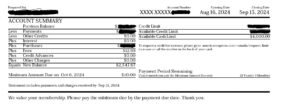Thinking about taking out a payday loan? Before you make that call, it’s important to understand the pros, cons, and costs involved. Let’s break down what you need to know so you can make a smarter decision.
Introduction
Payday loans might seem like a quick fix when you’re strapped for cash, but they often come with steep interest rates and fees that can surprise even the most prepared borrower. It’s essential to understand exactly how payday loans work, the risks they carry, and whether there might be better options out there. In this guide, we’ll walk you through the key things to consider before borrowing, so you can avoid a decision that could haunt your finances later on.
Take Sarah, a 28-year-old retail worker: “My car broke down, and I needed to fix it ASAP to get to work. I thought a payday loan was an easy solution, but it ended up causing months of financial stress. I wish I’d known more before signing up.”
What Exactly Are Payday Loans?
In a nutshell, payday loans are short-term, high-cost loans designed to cover you until your next paycheck. These loans typically range from $100 to $1,000, and are due within two to four weeks.
Unlike traditional loans, payday lenders don’t usually run a credit check. Instead, they need proof of your income and a bank account. The loan is secured by either a post-dated check or automatic withdrawal permission from your bank account.
Here’s how payday loans differ from the rest:
- Shorter terms: You typically need to repay by your next payday.
- Smaller loan amounts: These aren’t massive loans.
- Sky-high interest rates: Brace yourself.
- Easier to qualify: Bad credit? Not always a problem here.
Tom, a 35-year-old construction worker, explains his experience: “When I first heard about payday loans, I thought,‘This sounds simple enough.’ Borrow now, pay back on payday. But man, those fees and interest add up fast! It’s not like borrowing from a friend—it’s a whole different ballgame.”
Payday Loans: The Positive, The Negative, and The Unpleasant
The Positive
- Quick access to cash: You’ll often get funds within a day.
- No credit check: Even if your credit is shaky, you can still qualify.
- Convenient process: Many lenders allow you to apply online.
The Negative and the Unpleasant
- Astronomical interest rates: APRs can hit 400% or more.
- Short repayment periods: These can make it hard to repay on time.
- Potential for a debt spiral: People often end up borrowing again to pay off the first loan.
- Risk of bank fees: If the automatic withdrawal doesn’t go through, you could face overdraft fees.
The Hidden Costs of Pay day loans: Initial APR vs. Effective APR
When you’re looking at payday loans, understanding the difference between the advertised Annual Percentage Rate (APR) and the real cost—the effective APR—is key. It can make a huge difference in what you end up paying in the long run.
Initial APR vs. Effective APR
- Initial APR: This is the rate lenders will typically show you, based on the short-term nature of the loan, like a two-week period. It’s what’s quoted in your loan agreement and can seem high, but manageable.
- Effective APR: This is where things get real. It reflects the full cost of the loan over time, including all the fees and interest from rollovers, and is often way higher than the initial APR.
Payday Loan Calculator
Take Jake, a 29-year-old mechanic. He was shocked by how fast things spiraled: “I took out a $500 payday loan with an APR of 391%, which already seemed high, but I figured I’d pay it off fast. After three rollovers, I calculated that my effective APR had shot up to over 800%. It was a tough lesson about the real cost of these loans.”
Why Effective APR is Usually Higher
- Interest piles up: If you can’t repay the loan by your next payday, interest keeps building at the same high rate.
- More fees for rollovers: Lenders usually charge a fee every time you extend or “roll over” the loan, and this justadds to your total cost.
- The compounding effect: With each rollover, you’re paying interest on a growing balance, making the effective APR soar.
Sarah, a financial educator, uses a vivid analogy: “It’s like a snowball rolling downhill. Every time you roll over the loan, it picks up more snow—fees and interest—and gets bigger and faster. That’s why a 391% APR can end up costingyou much more if you can’t pay it off quickly.”
The Impact of Rollovers
Rollovers can seriously inflate the cost of your loan:
- Every rollover adds new fees and interest to your balance.
- Your debt grows, and so does the cost of borrowing.
- You could end up paying more in interest than you originally borrowed.
Maria, a 35-year-old retail worker, shared her story: “I borrowed $300, thinking I’d pay it back in two weeks. Six months later, after multiple rollovers, I had paid over $1,000 in fees and interest and still owed the original $300. It felt like financial quicksand—the more I struggled, the deeper I sank.”
Why It’s Important to Understand the Full Cost
Before getting a payday loan, make sure you’re thinking beyond the short-term. The initial terms might seem doable, but if you end up extending the loan, costs can skyrocket.
- Don’t just look at the first payment—consider what could happen if you need a rollover.
- Always ask the lender to explain the costs if you can’t pay back the loan on time.
Tom Greenwood, a financial advisor, offers this advice: “Before taking out a payday loan, ask yourself, ‘What if I can’tpay this back in two weeks?’ Do the math for one, two, or even three rollovers. The numbers might surprise you, but it’s better to know upfront than be blindsided later.”
Breaking Down the High Costs
Let’s break it down with a hypothetical payday loan of $500:
- Initial APR: 391%
- Fee per $100 borrowed: $15
- Total due after 2 weeks: $575
If you roll over three times (8 weeks total):
- Rollover fee each time: $75 (15% of $500)
- Total fees after 3 rollovers: $300
- Total owed after 8 weeks: $800
- Effective APR: Over 520%
In just eight weeks, the cost of the loan nearly doubled, and the effective APR is much higher than what you initially signed up for.
Understanding these factors is crucial before deciding on a payday loan. Always calculate what it could cost in the long run, especially if you think rollovers might be needed. There may be other options that save you money and help you avoid a debt trap.
The interest rates on payday loans are notoriously high. Let’s say you borrow $100 with a $15 fee. That might not sound bad, but over a year, it’s an APR of around 400%! Compare that to credit cards, where APRs generally range from 12% to 30%, and you start to see the picture.
Lisa, a 42-year-old single mom, shared her story: “I needed $300 for an emergency dental procedure, and the payday loan seemed like a lifesaver. But when I realized I’d be paying back almost $345 in just two weeks, I was floored. It didn’t feel like I had a choice at the time, though.”
How Payday Loans Impact Your Credit
Unfortunately, payday loans won’t help build your credit score, even if you repay on time. Most payday lenders don’treport to credit bureaus unless you default. But if you do miss payments, things can quickly go south:
- Your default may be reported to credit bureaus, damaging your score.
- Your debt could be sold to a collection agency, adding more stress.
- You could face legal action, which would further harm your credit.
Mike, a 31-year-old IT professional, shared: “I figured using a payday loan was smarter than maxing out my credit card, but when I couldn’t pay it back on time, my credit took a serious hit. I would’ve been better off just using the card.”
Payday Loan Regulations and Protections
Payday loans are tightly regulated by federal and state laws:
- Consumer Financial Protection Bureau (CFPB): Keeps an eye on payday lenders at the national level.
- State laws: Some states cap interest rates, limit fees, or restrict how many loans you can have at once.
To protect yourself:
- Make sure your lender is licensed in your state.
- Watch for clear disclosures on interest rates and fees.
- Be wary of lenders who seem pushy or don’t check your ability to repay.
Jennifer, a 39-year-old paralegal, offers this advice: “I had a bad experience with an online lender who seemed legit at first. Now, I always check my state’s financial regulation website to verify a lender’s license. It’s saved me from scams more than once!”
What Are the Alternatives to Pay day loans?
Before turning to a payday loan, consider these options:
- Personal loans from a bank or credit union.
- Credit card cash advances (pricier, but typically lower APR than payday loans).
- Borrowing from friends or family.
- Negotiating payment plans with your creditors.
- Seeking help from local charities or religious groups.
- Government assistance programs.
- Paycheck advance apps with lower fees.
Alex, a 26-year-old grad student, found a creative solution: “I was in a pinch and didn’t want to take out a payday loan, so I picked up some gig work on weekends. It wasn’t glamorous, but it got me the cash I needed without all the stress of high-interest loans.”
Borrow Responsibly
If you decide a payday loan is your only option, keep these tips in mind:
- Only borrow what you can afford to repay.
- Read the fine print—understand all the fees and terms.
- Budget carefully to ensure you can repay on time.
- Avoid rolling over loans, as this can trap you in debt.
- Focus on long-term solutions like building an emergency fund or improving your credit.
Rachel, a 33-year-old teacher, learned her lesson: “After using payday loans, I started a ‘crisis jar.’ Every month, I put in whatever I could, even if it was just $5. It’s a small buffer, but it gives me peace of mind, and I haven’t needed another loan since.”
Financial Recovery Is Possible
Many people have broken the payday loan cycle and regained control of their finances.
James, a 45-year-old sales rep, explains: “I was stuck in the payday loan loop for almost a year. What finally helped was reaching out to a non-profit credit counseling agency. They worked with me to create a budget, negotiate with my creditors, and set up a repayment plan. Now, I’m debt-free with a small savings cushion. It wasn’t easy, but it was worth it.”
Final Thoughts
Payday loans might offer a quick fix, but the long-term costs can be overwhelming. Before borrowing, make sure you fully understand what you’re getting into and explore all your options. If you’re consistently struggling to make ends meet, consider seeking help from a financial counselor. Remember, there are better, more sustainable ways to handle your finances than relying on payday loans.
As Maria, a seasoned financial counselor, says: “I’ve seen countless people struggle with payday loans. The key is to think long-term and make small changes. Even building a tiny emergency fund can help you avoid needing these loans. It’s never too late to start making smarter financial choices.”
By learning from others’ experiences and making informed decisions, you can handle financial emergencies without risking your future. You’re not alone—there are resources and alternatives available to help you through tough times.




